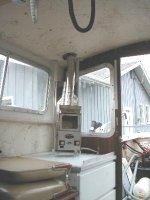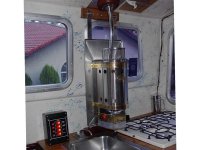drjohn71a":1n1vpk4h said:
Joe, I don't know about that clamshell idea. Has anyone else done that to a Wallas? I'd like to do something to eliminate the windage/backdraught problem.
John
I think the clamshell idea is worth a try, so when I was down at Marine General in Duluth earlier this week I picked up a 2" x 2" clamshell vent for about $8. It had three mounting holes; the one at the apex I ground off because it didn't match anything. The two at the open end were spaced 1 5/8" apart and the bolt spacing on my Wallas exhaust flange is 1 1/4". So I just squeezed the clamshell in a vice until the holes matched. When I give this a try this spring, I'll aim the clamshell toward the stern. The Wallas exhaust is 1" in diameter and the ID of my altered clamshell is about 3/4" x 3/4", so I'm hoping I'm not introducing a restriction. I'm also hoping I don't scorch the side of the boat by directing hot exhaust gasses along side it. Anyway, I think it's worth a try as an attempt to solve the backdraught issue. I'll keep you posted.
Al






